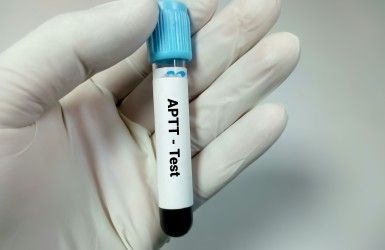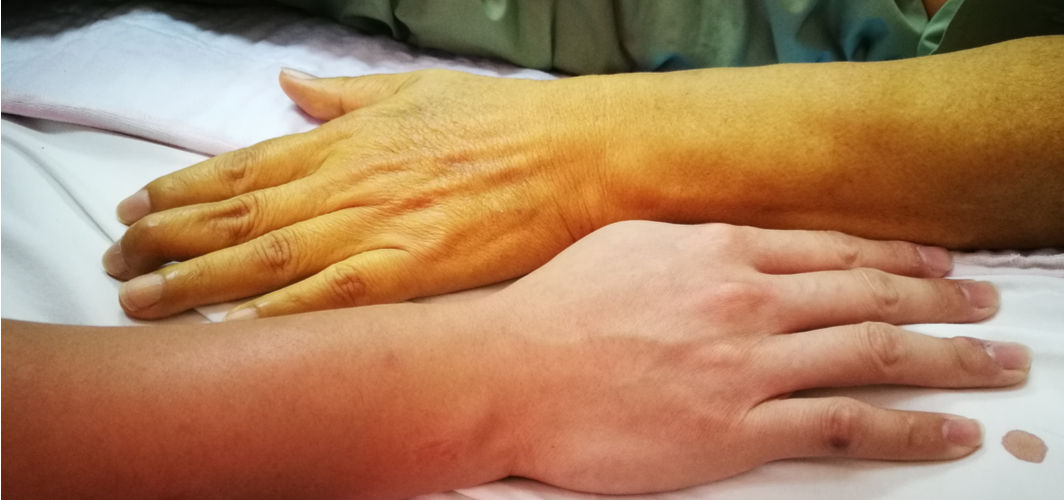General Health
On Blood Thinners or Facing Unexplained Bleeding? An APTT Test Can Check Your Clotting Time
6 min read
By Apollo 24|7, Published on - 30 May 2025
Share this article
0
0 like

If you are taking blood thinners or experiencing unexplained bleeding or bruising, you may feel overwhelmed or anxious about what’s happening inside your body. One important test that doctors often recommend in such situations is the APTT test, a diagnostic tool that measures how long it takes your blood to clot. This test is particularly vital for patients on anticoagulant medications, those undergoing surgery, or individuals with bleeding disorders.
In this article, we’ll explain everything you need to know about the APTT test: what it is, why it matters, when it's recommended, and how to interpret your results. We’ll also explore how this test fits into broader clotting disorder evaluations and what steps you may need to take depending on your outcome.
What Is an APTT Test?
The APTT test, short for Activated Partial Thromboplastin Time, is a blood test that evaluates the integrity of your blood clotting process. Specifically, it measures the time it takes for your blood to form a clot after certain activating substances are added in a laboratory setting.
The process of clotting, or coagulation cascade, involves a coordinated series of events as well as proteins referred to as clotting factors. These factors operate in conjunction to avoid excess bleeding in case you get injured. Any interference in such a cascade, whether by medication, inherited disorders, or medical conditions, can result in bleeding or excess blood clots. The APTT test primarily evaluates the intrinsic and common pathways of coagulation. It checks for deficiencies or inhibitors of clotting factors like Factor VIII, IX, XI, and XII.
Why Is the APTT Test Important?
The APTT test plays a critical role in diagnosing and monitoring various medical conditions and treatments, including:
1. Monitoring Anticoagulant Therapy
If you’re on heparin, a commonly prescribed blood thinner, your doctor may order frequent APTT tests to ensure your dosage is safe and effective. A value that’s too high could indicate that your blood is too slow to clot, increasing the risk of dangerous bleeding. On the other hand, a value that's too low may mean the heparin is not working effectively.
2. Investigating Unexplained Bleeding or Bruising
If you have unexplained nosebleeds, heavy menstrual periods, or frequent bruising without injury, an APTT test can help pinpoint whether a clotting disorder is to blame.
3. Pre-Surgical Screening
Before undergoing surgery, it's essential to know how well your blood clots. The APTT test can identify potential risks for bleeding during or after the procedure.
4. Diagnosing Bleeding Disorders
Certain inherited bleeding disorders, such as haemophilia A or haemophilia B, can be detected with the help of an APTT test. These conditions often involve deficiencies in clotting factors that prolong the clotting time.
5. Detecting Lupus Anticoagulant
Paradoxically, some autoimmune conditions like lupus may result in the presence of lupus anticoagulants, substances that prolong the APTT result even though the patient is more prone to clotting than bleeding. The APTT test, along with other tests, helps in their detection.
Who Should Consider the APTT Test?
Your healthcare provider may recommend an APTT test in the following circumstances:
- You are taking anticoagulants such as unfractionated heparin.
- You have symptoms of a bleeding disorder: frequent bruises, gum bleeding, prolonged bleeding from cuts, or joint swelling.
- You’re scheduled for surgery and need a pre-operative clotting assessment.
- You have a family history of bleeding disorders, such as haemophilia.
- You have a history of recurrent miscarriages, which can sometimes be related to clotting issues like antiphospholipid syndrome.
- You are suspected of having an autoimmune condition that might affect your blood's ability to clot properly.
How to Prepare for an APTT Test?
Generally, there is no special preparation required for an APTT test. However, your doctor might give you specific instructions depending on your medical history or current medications.
Here’s what you should consider:
- Medication Disclosure: Inform your healthcare provider about any prescription or over-the-counter medicines you’re taking, especially blood thinners, aspirin, or vitamin supplements. These can influence your test results.
- Diet and Fasting: Fasting is not usually required unless the test is combined with other blood tests that require fasting.
- Recent Infections or Illnesses: Inform your doctor if you've had any recent infections or are currently ill, as this can sometimes affect your clotting profile.
What Happens During the APTT Test?
The APTT test is a simple and quick blood test. Here’s what typically happens:
- Sample Collection: A healthcare provider will draw a small sample of blood, usually from a vein in your arm.
- Laboratory Analysis: The blood sample is sent to a laboratory, where reagents (activating chemicals) are added to it. The time it takes for the blood to clot is measured.
- Turnaround Time: Results are typically available within a few hours to a day, depending on the lab.
The entire process is low-risk and usually takes less than five minutes to complete.
Have more questions?
Understanding APTT Test Results
APTT test results are usually reported in seconds, indicating how long it takes for your blood to clot under controlled laboratory conditions.
1. Normal Range
The normal APTT range typically falls between 30 to 40 seconds, although this can vary slightly between laboratories due to differences in reagents and measurement techniques.
2. Prolonged APTT
If your APTT time is longer than normal, it may suggest:
- Use of heparin or other anticoagulants
- Liver disease (as clotting factors are made in the liver)
- Inherited factor deficiencies (e.g., Haemophilia A - Factor VIII deficiency)
- Presence of lupus anticoagulant or antiphospholipid antibodies
- Von Willebrand disease
3. Shortened APTT
This is less common but may occur due to:
- Inflammatory states
- Disseminated intravascular coagulation (DIC) in the early stages
- A high level of Factor VIII (e.g., during stress, pregnancy, or illness)
It's essential to remember that APTT results should always be interpreted in conjunction with other tests, such as the PT (Prothrombin Time) test, platelet count, and clinical history.
Are There Any Risks Involved?
The APTT test itself is very safe. Risks associated with the blood draw are minimal and may include:
- Mild pain or bruising at the needle site
- Rarely, infection or excessive bleeding at the puncture site
- Let the healthcare professional know if you experience prolonged bleeding after the sample is taken.
Conclusion
The APTT test is a crucial diagnostic and monitoring tool that helps assess your blood’s ability to clot properly. Whether you’re on anticoagulant therapy, preparing for surgery, or dealing with unexplained bleeding, this test provides vital insights into your coagulation system. By identifying abnormal clotting times, healthcare professionals can make informed decisions about treatment strategies, dosage adjustments, and further diagnostic steps. Timely detection and intervention can be life-saving, especially for those at high risk of bleeding or clotting complications. If you or a loved one is on blood thinners or experiencing unusual symptoms related to bleeding, speak to your doctor about whether the APTT test might be appropriate for your situation.
Book an APTT Test
General Health
Frequently Asked Questions
Is the APTT test the same as the PT test?
Is the APTT test the same as the PT test?
Can I take the APTT test while on warfarin?
Can I take the APTT test while on warfarin?
How often should I take the APTT test while on heparin?
How often should I take the APTT test while on heparin?
What should I do if my APTT result is abnormal?
What should I do if my APTT result is abnormal?
Can I lead a normal life with an abnormal APTT?
Can I lead a normal life with an abnormal APTT?
Leave Comment
Recommended for you

General Health
Adult Jaundice: Early Signs to Look out For
Jaundice is a condition in which the skin, sclera (white part of the eyes), and mucous membranes of the body turn yellow. In most cases, it resolves with a change in diet and lifestyle.
.jpg?tr=q-80)
General Health
ECG Test – Normal Range, Purpose, Procedure, And Results Interpretation
Learn about the ECG test: its purpose in diagnosing heart conditions, the simple procedure, understanding normal ranges, and interpreting your results.

General Health
Does Acupressure Work? Here's What Experts Say
Acupressure is a complementary therapy that originates from traditional Chinese medicine. While research on acupressure is limited, initial findings suggest it can help alleviate pain and discomfort caused by various conditions. This article underlines how acupressure works and whether or not it is actually effective.
Subscribe
Sign up for our free Health Library Daily Newsletter
Get doctor-approved health tips, news, and more.
Visual Stories

Could There Be More to Your Snore?
Tap to continue exploring
Recommended for you

General Health
Adult Jaundice: Early Signs to Look out For
Jaundice is a condition in which the skin, sclera (white part of the eyes), and mucous membranes of the body turn yellow. In most cases, it resolves with a change in diet and lifestyle.
.jpg?tr=q-80)
General Health
ECG Test – Normal Range, Purpose, Procedure, And Results Interpretation
Learn about the ECG test: its purpose in diagnosing heart conditions, the simple procedure, understanding normal ranges, and interpreting your results.

General Health
Does Acupressure Work? Here's What Experts Say
Acupressure is a complementary therapy that originates from traditional Chinese medicine. While research on acupressure is limited, initial findings suggest it can help alleviate pain and discomfort caused by various conditions. This article underlines how acupressure works and whether or not it is actually effective.